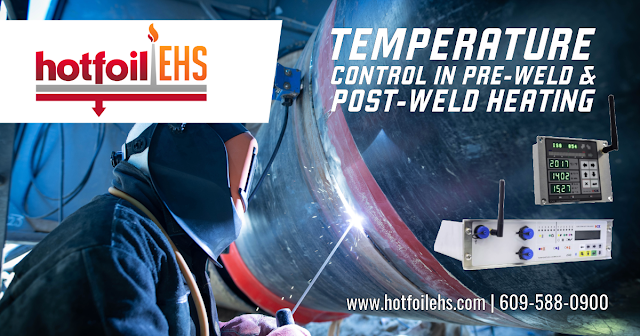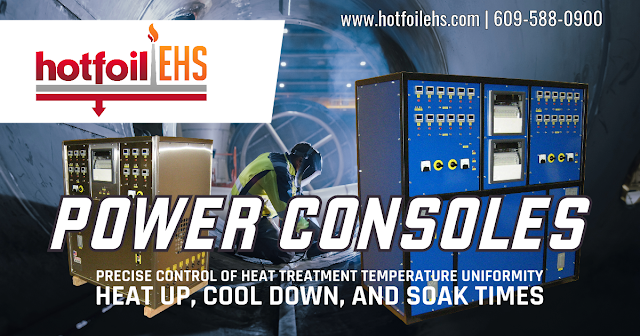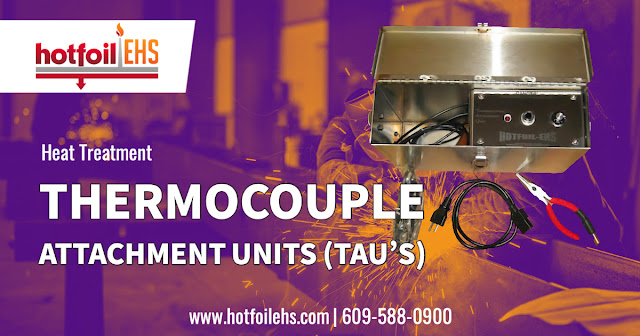A blog that provides educational information on electric heating systems used on hoppers, chutes, tanks and vessels; electric heating systems used for pre and post weld heat treating; heat treating power consoles; custom heat treating furnaces; and single & multi-operator welders. For more information, visit HotfoilEHS.com
Pre-weld Heating and Post-weld Heat Treatment: Essential Steps for Infrastructure Integrity
Enhancing Electrostatic Precipitators with Custom Air Preheaters from Hotfoil-EHS
https://hotfoilehs.com
609-588-0900
The Crucial Role of Part Temperature Control in Pre-Weld and Post-Weld Heating
https://hotfoilehs.com
609-588-0900
The Role of Heat Treatment Power Consoles in Welding
In metal fabrication and construction, welding is a pivotal process that ensures the robustness and durability of metal structures. It's more than just joining metals; it's about ensuring the joint can withstand stress and last long. This is where the role of heat treatment becomes indispensable. Heat treatment power consoles are paramount among the various tools used for this purpose.
What is a Heat Treatment Power Console?
Like those in the provided image, heat treatment power consoles are devices designed to control heat application to metals during post-weld heat treatment (PWHT). They come with a range of switches, dials, and connectors that allow operators to set specific temperatures, monitor heat levels, and control the duration of the treatment.
Why is Heat Treatment Necessary?
After welding, metals often undergo structural changes at their molecular level. These changes can lead to internal stresses, reduced ductility, and increased brittleness. Heat treatment, therefore, becomes essential to:
- Relieve internal stresses.
- Improve mechanical properties like tensile strength and ductility.
- Reduce the risk of corrosion.
- Enhance the overall lifespan of the weld.
The Significance of Power Consoles
- Precision Control: With a power console, operators can precisely control the temperature to which the metal is exposed, ensuring that the metal undergoes optimal heat treatment, neither too much nor too little.
- Uniform Heating: These consoles provide consistent and uniform heating across the welded area, which is crucial as uneven heating can lead to new stresses or distortions.
- Safety: High-quality consoles come with safety features like overheat protection and alarms, ensuring the safety of the equipment and the operator.
- Documentation & Monitoring: Modern power consoles may offer features like data logging, allowing operators to monitor the heat treatment process closely and maintain records for quality assurance.
Impact on Metal Fabrication & Construction
In industries like metal fabrication and construction, where the integrity of welds is critical, heat treatment power consoles play a defining role.
- They ensure that large structures like bridges, skyscrapers, and pipelines remain durable and safe.
- In the automotive and aerospace industries, where the precision of welds is crucial, these consoles guarantee that parts can withstand intense pressures and stresses.
Conclusion
Welding, though a fundamental process, comes with its set of challenges. The post-weld molecular changes in metals can compromise the quality of the weld. However, these challenges are effectively addressed with tools like heat treatment power consoles. By ensuring the robustness of welds, these consoles contribute significantly to the longevity and safety of metal structures in various industries. The next time you witness a magnificent metal structure, remember the unsung hero behind it - the heat treatment power console.
https://hotfoilehs.com
609-588-0900
Understanding the Importance of Ceramic Mat Heaters in Pre-Weld Heating Applications
Thermocouple Attachment Units in Heat Treatment
Thermocouples play a crucial role in the heat treatment industry, particularly welding. A thermocouple is a type of sensor consisting of two different types of metal joined together at one end. When the joined end is heated or cooled, it creates a micro voltage correlated to the temperature.
The Thermocouple Attachment Unit (TAU) is a crucial device used to construct and apply these thermocouples to the workpieces or target pieces that will be welded.
Construction of Thermocouples:
- Preparation of Thermocouple Wire: The first step in constructing a thermocouple involves preparing the thermocouple wire. These wires are two different types of metal, with their choice depending on the temperature range and the environmental conditions of the process.
- Joining the Wires: The two thermocouple wires connect at one end by twisting the two wires together and then applying heat, generally through a method such as welding or brazing.
Application of Thermocouples to Welding Target Pieces:
- Location Selection: The thermocouples need to be attached strategically to effectively monitor the temperature of the workpiece during the welding process. These locations are generally where the thermal properties are most critical for the quality of the weld, such as the weld joint or near heat-affected zones.
- Attachment: The TAU is then used to attach the thermocouple to the selected location on the workpiece. The attachment is typically done by welding the bead of the thermocouple to the workpiece. The TAU can often control this process to ensure a good connection without damaging the thermocouple.
- Connection to Measurement Device: After attachment, the other end of the thermocouple is connected to a temperature measurement device or system. This device measures the thermocouple's voltage and translates it into a temperature reading.
During the welding process, the thermocouple provides real-time temperature data, helping to control the weld's heating and cooling rates, ensuring the weld reaches the appropriate temperatures without overheating or cooling too quickly, both of which can lead to weld defects. After the process, thermocouples can be removed or left in place, depending on the requirements.
Remember, the specific process can vary based on the type of TAU and the particular requirements of the welding operation. Always refer to the manufacturer's instructions when using a TAU.
https://hotfoilehs.com
609.588.0900
Hotfoil-EHS Power Consoles: Eurotherm Master Controller Set-up for PWHT Procedure
This video explains how to set up the Eurotherm Temperature Controller on a Hotfoil-EHS Power Console in a Primary/Secondary relationship.
Understanding heating rate, soaking temperature, soaking time and cooling rate for PWHT (Post Weld Heat Treatment)
Post-weld heat treatment (PWHT) is a crucial step in the welding process, as it helps to mitigate the adverse effects of welding on the microstructure and mechanical properties of the welded components. The main objectives of PWHT are to reduce residual stresses, improve ductility, reduce the risk of stress corrosion cracking, and temper or soften the heat-affected zone (HAZ). The four key factors that influence the effectiveness of PWHT are heating rate, soaking temperature, soaking time, and cooling rate.
- Heating rate: The heating rate refers to the rate at which the temperature of the welded component increases to reach the desired soaking temperature. A controlled and uniform heating rate is essential to avoid the formation of undesirable temperature gradients within the material, which can lead to distortion and cracking. A slow, steady heating rate also ensures that the material undergoes sufficient thermal stress relief, reducing residual stresses and improving the mechanical properties.
- Soaking temperature: The soaking temperature is the target temperature at which the material stays during the heat treatment. The selection of an appropriate soaking temperature is vital, as it determines the extent of stress relief, the softening of the HAZ, and the overall improvement of mechanical properties. The soaking temperature is carefully chosen based on the material's composition, prior heat treatment, and the desired outcomes of the PWHT. Too high a temperature may cause grain coarsening and reduce the material's strength, while too low a temperature may not provide adequate stress relief or soften.
- Soaking time refers to the duration the material holds at the soaking temperature. The soaking time is critical for allowing sufficient time for the microstructural changes to occur, such as diffusion of hydrogen, precipitation of carbides, or tempering of martensite. Proper soaking time reduces residual stresses and improves ductility and the desired microstructural changes. Insufficient soaking time can lead to incomplete stress relief, while excessive soaking time may result in grain coarsening, which can adversely affect the material's mechanical properties.
- Cooling rate: The cooling rate is the rate at which the temperature of the material reduces after the completion of the soaking phase. The cooling rate significantly influences the material's final microstructure and mechanical properties. Controlled and uniform cooling is essential to prevent thermal gradients that could cause distortion or cracking. Different cooling rates may be required depending on the material and the desired outcome. Faster cooling may achieve a harder, more robust microstructure, while slower cooling rates can produce a more ductile, softer material.
In summary, the heating rate, soaking temperature, soaking time, and cooling rate are essential parameters requiring careful controlling during post-weld heat treatment. These factors determine the effectiveness of the heat treatment process in reducing residual stresses, improving ductility, reducing the risk of stress corrosion cracking, and achieving the desired microstructure and mechanical properties in the welded components.





